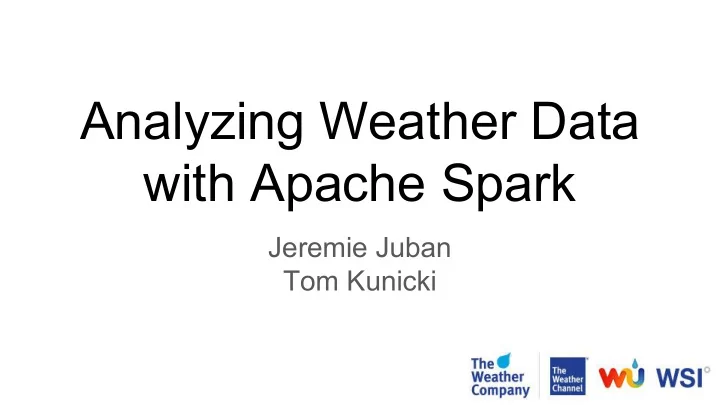

Analyzing Weather Data with Apache Spark Jeremie Juban Tom Kunicki
Introduction ● Who we are ○ Professional Services Division of The Weather Company ● What we do ○ Aviation ○ Energy ○ Insurance ○ Retail ● Apache Spark at The Weather Company ○ Feature Extraction ○ Predictive Modeling ○ Operational Forecasting
Goals ● Present high-level overview of Apache Spark ● Quick overview of gridded weather data formats ● Examples of how we ingest this data into Spark ● Provide insight into simple Spark operations on data
What is Spark? Spark is a general-purpose cluster computing ● Fast to run framework ○ Mode the code not the data 2009 - Research project at UC Berkeley ○ Lazy evaluation of big data queries 2010 - Donated to Apache S.F. 2015 - Current release Spark 1.5 ○ Optimizes arbitrary operator graphs Generalization over MapReduce ● Fast to write ○ Provides concise and consistent APIs in Scala, Java and Python. ○ Offers interactive shell for Scala/Python.
Resilient Distributed Dataset “A Resilient Distributed Dataset ( RDD ), the basic abstraction in Spark. Represents an immutable, partitioned collection of elements that can be operated on in parallel.” source: spark documentation ● Data are partitioned at the worker nodes ○ Enable efficient data reuse ● Store data and its transformations ○ Fault tolerant, coarse grain operations ● Two types of operations ○ Transformations (lazy evaluation) ○ Actions (trigger evaluation) ● Allow caching/persisting ○ MEMORY_ONLY , MEMORY_AND_DISK, DISK_ONLY...
RDD operation flow Flow Type Example Flow Diagram Filter Transformation filter, distinct, substractByKey Map Transformation map, mapPartitions Scatter Transformation flatMap, flatMapValues Transformation aggregate, reduceByKey Gather Action reduce, collect, count, take
RDD set operations ● Union ● Intersection RDD 1 RDD 2 ● Join ● leftOuterJoin ● RightOuterJoin ● Cartesian ● Cogroup RDD 3
Loading Gridded Data into RDD ● Multi-dimensional gridded data ○ Observational, Forecast ○ Varying dimensionality ● Distributed in various binary formats for each rt in ...: ○ NetCDF, Grib, HDF, … for each e in ...: for each vt in ...: ● NetCDF-Java/CDM for each z in ...: ○ Common Data Model (CDM) for each y in ...: for each x in ...: ○ Canonical library for reading // magic! ● Many. Large. Files.
Load Gridded Data into RDD (HDFS?) ● HDFS = H adoop D istributed F ile S ystem ● Standard datastore used with Spark ● Text delimited data formats are "standard", meh... ● Binary formats available, conversion? how? ● What about reading native grid formats from HDFS? ○ Work required to generalize storage assumptions for NetCDF-Java/CDM
Loading Gridded Data into RDD (Options?) ● Want to maintain ability to use NetCDF-Java ● NetCDF-Java assumes file-system and random access ● Distributed filesystems (NFS, GPFS, …) ● Object Store (AWS S3, OpenStack Swift)
Loading Gridded Data into RDD (Object Stores) ● Partition data and archive to key:value object store ● Map data request to list of keys ● Generate RDD from list of keys and distribute ( partitioning! ) flatMap object store key to RDD w/ data values ● RDD[key] => RDD[((param, rt, e, vt, z, y, x), value)]
Loading Gridded Data into RDD (Object Stores S3) ● Influences Spark cluster design ○ Maximize per-executor bandwidth for performance ○ Must colocate AWS EC2 instances in S3 region (no transfer cost) ● Plays well with AWS Spark EMR ● Can store to underlying HDFS in Spark friendly format. ● Now what do we do with our new RDD?
RDD Filtering data: RDD[(key: (g, rt, e, vt, z, y, x) , value: Double )] → ECMWF Ensemble operational = 150 × 2 × 51 × 85 × 62 × 213988 = 17 trillion data point per day 1. Filter Definition of a filtering function: f(key) : Boolean Example // Filter data - option 1: RDD val dataSlice = data. filter ( d => d._1 == "t2m" && // 2 meter temperature d._2 == ”6z” && // 6z run d._4 <= 24 && // first 24 hours d._6 > minLa && d._6 < maxLa && // Lo/La bounding box d._7 > minLo && d._7 < maxLo) // Filter data - option 2: DataFrame sqlContext.sql( "SELECT * FROM data WHERE g<32 AND rt=’6z’ AND vt<= 24 AND ..." )
RDD Spatio-temporal Translations 1. flatMap Definition of a key mapper f(key) : key ● Shift time/space key (opposite sign) x(t-1) ● Emit a new variable name Example y(t) x(t-2) Model Generate the past 24 hours lagged variables ... data: RDD[(key: (g, rt, vt) , value: Double )] x(t-i) // Lagged variables val dataset = data.flatMap(x=>(0 until 24).map(i => ( ( x._1._1+"_m"+i+"h", x._1._2+i, x._1._3), // key x._2 ) ) // value )
RDD Smoothing/Resampling 1. Map Example Key truncation function f(key) : key (37 126) (37 127) Rounding ● Spatial - nearest neighbour, rounding/shift ● Temporal - time truncation (37.5 126.5) 2. ReduceByKey Aggregation function f(Vector(value)) : value (38 126) (38 127) ● Sum ● Average ● Median (37.386,126.436) → (37.5,126.5) ● ...
RDD Smoothing/Resampling Temporal example x(t) compute daily cumulative value x(t-1) + Model y(t) dataset : RDD[( key : LocalDateTime, value : Double)] ... x(t-i) // Daily sum val dataset_daily = dataset.map( t => (t._1.truncatedTo(ChronoUnit.DAYS),t._2) ) var dataset_fnl = dataset_daily.reduceByKey( (x,y) => (x+y) )
RDD Moving Average 1. Complete missing keys and sort by time ○ subtract → list missing key ○ union → complete the set 2. Apply a sliding mapper ○ key reduction function f(Vector(Key)) : key value reduction function f(Vector(value) : value ○ // Moving Average val missKeys = fullKSet.subtract(dataset.keys); val complete = dataset.union(missKeys.map(x => (x,NaN))).sortByKey() val slider = complete.sliding(3) // Key reduction (and NaN cleaning) val reduced = slider.map(x => ( x.last._1, x.map(_._2).filter(!_.isNaN) )) // Value reduction val dataset_fnl = slider.mapValues(x => math.round(x.sum / x.size))
Thank you!
Recommend
More recommend